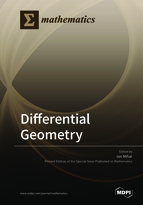Differential Geometry
A special issue of Mathematics (ISSN 2227-7390).
Deadline for manuscript submissions: closed (30 November 2018) | Viewed by 44829
Special Issue Editor
Interests: differentiable manifolds; Riemannian manifolds; distinguished vector fields; Riemannian invariants; sectional curvature; complex manifolds; contact manifolds; affine manifolds; statistical manifolds; submanifold theory
Special Issues, Collections and Topics in MDPI journals
Special Issue Information
Dear Colleagues,
Differential geometry is the field of mathematics that studies geometrical structures on differentiable manifolds by using techniques of differential calculus, integral calculus, and linear algebra. Starting from some classical examples (open sets in Euclidean spaces, spheres, tori, projective spaces, Grassmannians, etc.) one may construct new manifolds by using algebraic tools: Product of manifolds, quotient spaces, pull-back of manifolds by smooth functions, tensor product of submanifolds, etc.
Differential geometry became a field of research in late 19th century, but it is very actual by its applications and new approaches. In order to determine the lengths of curves, the areas of surfaces, and the volumes of manifolds, the geometers have considered Riemannian manifolds, or, more generally, pseudo-Riemannian manifolds. On such manifolds, distinguished vector fields (Killing, conformal, concurrent, torse forming vector fields) have interesting applications in geometry and relativity. Curvature invariants are the most natural and most important Riemannian invariants as they play key roles in physics and biology. Among the Riemannian curvature invariants, the most investigated are the sectional curvature, scalar curvature, Ricci curvature, and Chen invariants. Mostly studied are the Riemannian manifolds endowed with certain endomorphisms of their tangent bundles: Almost complex, almost product, almost contact, almost paracontact manifolds, etc. More general manifolds, for instance, affine manifolds and statistical manifolds, are also considered. On the other hand, the geometry of submanifolds in Riemannian manifolds is an important topic of research in differential geometry. Its origins are in the theory of curves and surfaces in the three-dimensional Euclidean space. Obstructions to the existence of minimal, Lagrangian, slant submanifolds were obtained in terms of their Riemannian curvature invariants.
The purpose of this Special Issue is to provide a collection of papers that reflect modern topics of research and new developments in the field of differential geometry and explore applications in other areas.
Prof. Dr. Ion Mihai
Guest Editor
Keywords
- differentiable manifolds
- Riemannian manifolds
- distinguished vector fields
- Riemannian invariants
- sectional curvature
- complex manifolds
- contact manifolds
- affine manifolds
- statistical manifolds
- submanifold theory






